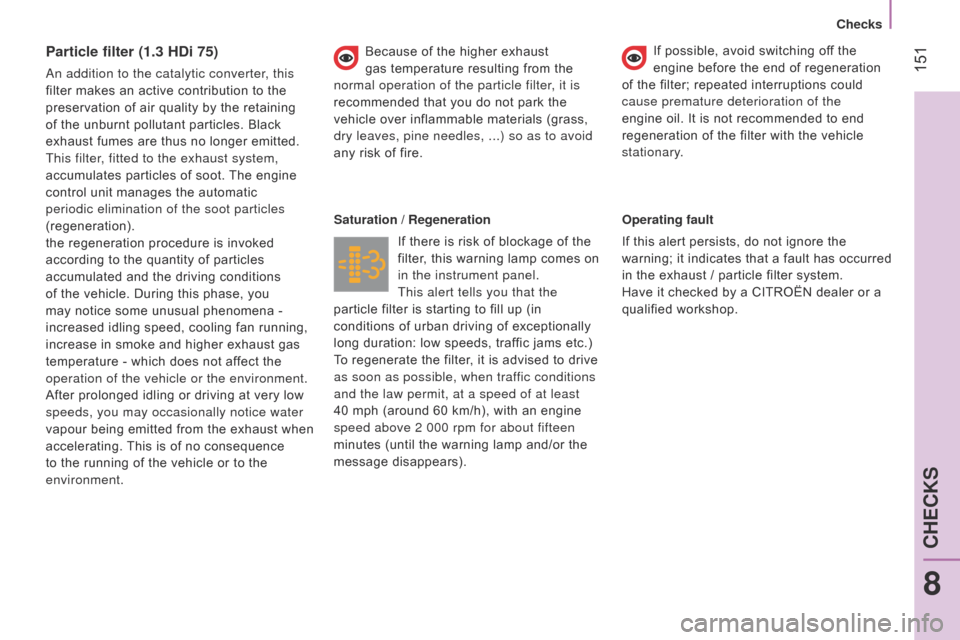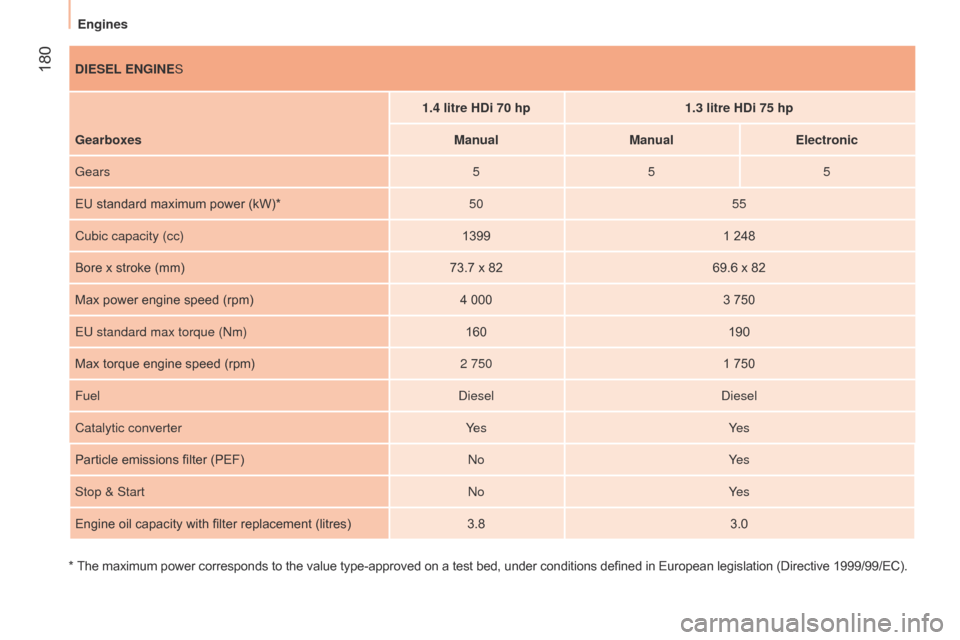Engine speed Citroen NEMO RHD 2015 1.G User Guide
[x] Cancel search | Manufacturer: CITROEN, Model Year: 2015, Model line: NEMO RHD, Model: Citroen NEMO RHD 2015 1.GPages: 193, PDF Size: 8.3 MB
Page 153 of 193

151
Particle filter (1.3 HDi 75)
an addition to the catalytic converter, this
filter makes an active contribution to the
preservation of air quality by the retaining
of the unburnt pollutant particles. Black
exhaust fumes are thus no longer emitted.
This filter, fitted to the exhaust system,
accumulates particles of soot. The engine
control unit manages the automatic
periodic elimination of the soot particles
(regeneration).
the regeneration procedure is invoked
according to the quantity of particles
accumulated and the driving conditions
of the vehicle. During this phase, you
may notice some unusual phenomena -
increased idling speed, cooling fan running,
increase in smoke and higher exhaust gas
temperature - which does not affect the
operation of the vehicle or the environment.
After prolonged idling or driving at very low
speeds, you may occasionally notice water
vapour being emitted from the exhaust when
accelerating. This is of no consequence
to the running of the vehicle or to the
environment. Saturation / Regeneration
If there is risk of blockage of the
filter, this warning lamp comes on
in the instrument panel.
This alert tells you that the
particle filter is starting to fill up (in
conditions of urban driving of exceptionally
long duration: low speeds, traffic jams etc.)
To regenerate the filter, it is advised to drive
as soon as possible, when traffic conditions
and the law permit, at a speed of at least
40 mph (around 60 km/h), with an engine
speed above 2 000 rpm for about fifteen
minutes (until the warning lamp and/or the
message disappears). Operating fault
If this alert persists, do not ignore the
warning; it indicates that a fault has occurred
in the exhaust / particle filter system.
Have it checked by a CITROËN dealer or a
qualified workshop.
Because of the higher exhaust
gas temperature resulting from the
normal operation of the particle filter, it is
recommended that you do not park the
vehicle over inflammable materials (grass,
dry leaves, pine needles,
...) so as to avoid
any risk of fire. If possible, avoid switching off the
engine before the end of regeneration
of the filter; repeated interruptions could
cause premature deterioration of the
engine oil. It is not recommended to end
regeneration of the filter with the vehicle
stationary.
8
CHECKS
Checks
Page 172 of 193

170Marking RatingFunctions
F01 60
a
Control unit
F02 40
A Passenger compartment fan.
F03 20
a
Starter motor supply
F04 40
A ABS hydraulic block pump supply
F06 30 A Single speed cooling fan control
F07 40 A High speed cooling fan control
F08 30 A Air conditioning compressor
F09 15 ATowbar harness.
F10 10 AHorn
F 11 10 A Engine management secondary load supply
F14 15 AMain beam headlamps
F15 15 A 12 V accessory socket.Table of fuses in the engine
compartment
Changing a fuse
Page 182 of 193

180DIESEL ENGINES1.4 litre HDi 70 hp1.3 litre HDi 75 hp
Gearboxes ManualManualElectronic
Gears 555
EU standard maximum power (kW)* 5055
Cubic capacity (cc) 13991 248
Bore x stroke (mm) 73.7 x 8269.6 x 82
Max power engine speed (rpm) 4 0003 750
EU standard max torque (
n m) 160 190
Max torque engine speed (rpm) 2 7501 750
Fuel
d
iesel
d
iesel
Catalytic converter Ye sYe s
Particle emissions filter (PEF)
n
oYe s
Stop & Start
n
oYe s
Engine oil capacity with filter replacement (litres) 3.83.0
* The maximum power corresponds to the value type-approved on a test bed, under conditions defined in European legislation (Directive 1999/99/EC).
Engines
Page 183 of 193

181PETROL ENGINE1.4 litre 75 hp
Gearbox Manual
Gears 5
EU standard maximum power (kW)* 54
Cubic capacity (cc) 1 360
Bore x stroke (mm) 75 x 77
Max power engine speed (rpm) 5 200
EU standard max torque (
n m) 11 8
Max torque engine speed (rpm) 2 600
Fuel Unleaded petrol
Stop & Start
n
o
Engine oil capacity with filter replacement (litres) 3.0
* The maximum power corresponds to the value type-approved on a test bed, under conditions defined in European legislation (Directive 1999/99/EC).
Engines
TECHNICAL DATA
10
Page 184 of 193

182
WEIGHTS AND TOWED LOADS
The maximum weights and towed loads
for your vehicle are given are given in the
registration document, as well as in sales
brochures.
These values are also present on the
manufacturer's plate or label (see the
"Technical data - Identification markings"
section). The kerb weight is equal to the unladen
weight
+ driver (75 kg).
The gross train weight and towed load values
indicated apply up to a maximum altitude
of 1
000 metres; the towed load mentioned
must be reduced by 10 % for every additional
1
000 metres.High ambient temperatures may result
in a reduction in the performance of
the vehicle to protect the engine; when the
ambient temperature is higher than 37 °C, limit
the towed weight.
Towing with a lightly loaded vehicle can
adversely affect roadholding.
Braking distances are increased when towing
a trailer.
When towing, the maximum speed allowed is
reduced (comply with the legislation in force in
your country).
For information on the maximum trailer weight
for your vehicle, contact a CITR
o Ë n dealer or
a qualified workshop. The weight of the braked trailer can be
increased, within the GTW limit, on condition
that the GVW of the towing vehicle is reduced
by the same amount.
The recommended nose weight is the vertical
load on the towbar ball (removable with or
without tools).
GVW: gross vehicle weight, the maximum
authorised vehicle weight.
GTW: gross train weight, the maximum
authorised weight of vehicle plus trailer.
In all countries, it is essential to comply with
the local legislation on towed loads.
Weights